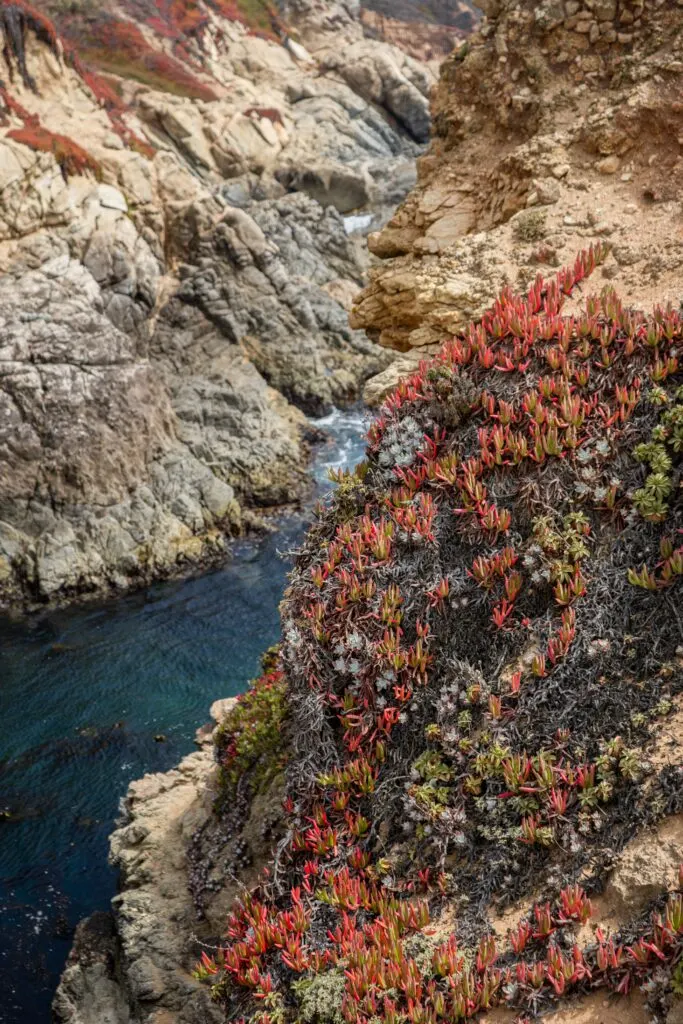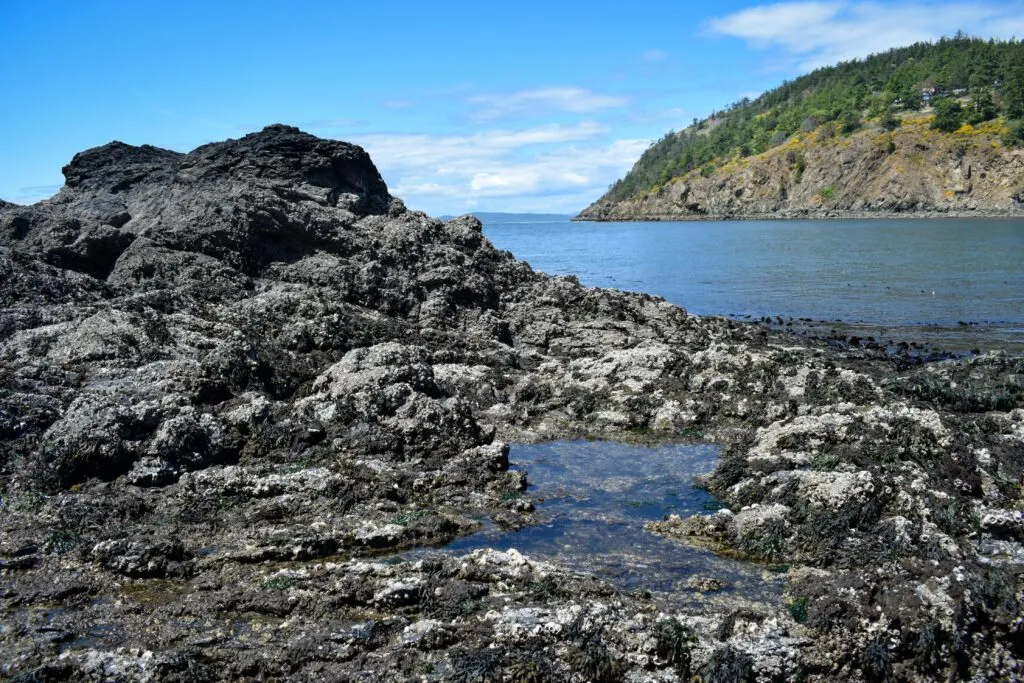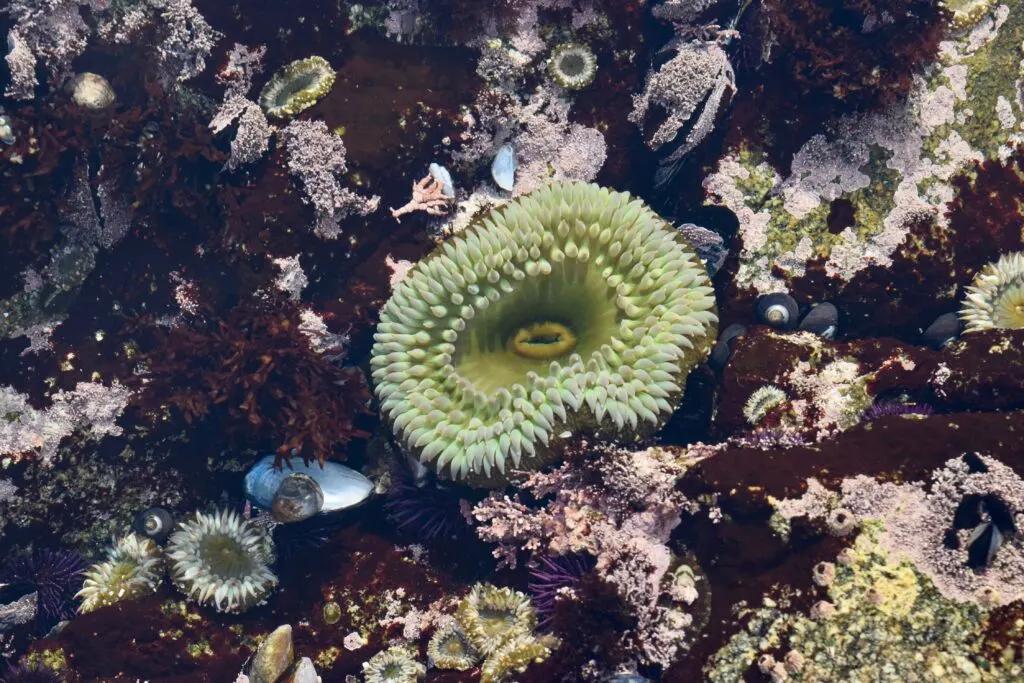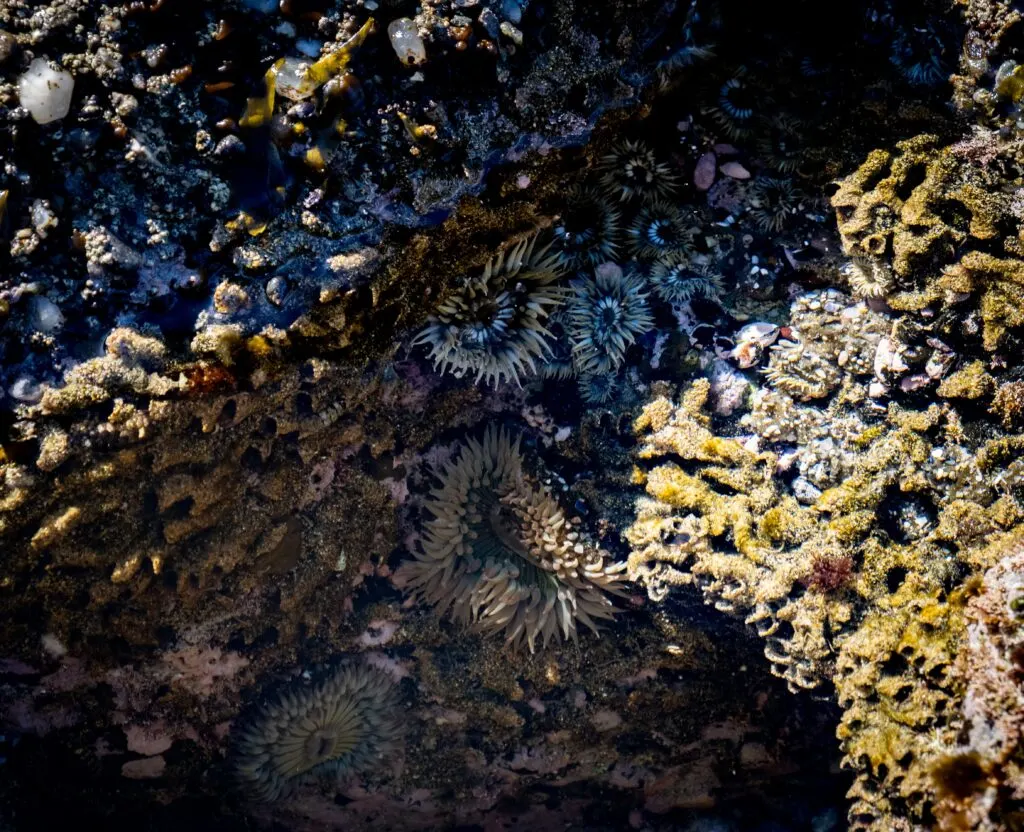Are you looking for a unique and exciting adventure in Northern California? Look no further than the tide pools that dot the rocky coastline. These natural wonders offer a glimpse into a world of marine life that is both fascinating and beautiful.

Tide pools are formed when the ocean recedes, leaving behind pockets of water in the rocky crevices along the shore. These pools are home to a wide variety of marine creatures, from colorful anemones to scuttling crabs. Exploring the tide pools is like taking a journey to another world, where the rules are different and the inhabitants are unlike anything you've ever seen.
Northern California is home to some of the most diverse and accessible tide pools in the state, including Fitzgerald Marine Reserve and Duxbury Reef at Agate County Park. Before you set out on your adventure, be sure to consult tide tables to determine the best time to visit. Low tide is the best time to explore the tide pools, as they are most exposed and easier to access. So grab your sunscreen, your sense of adventure, and get ready to explore the magical world of tide pools in Northern California.
Tide Pools in Northern California: A Guide to Exploring the Coastline
Understanding Tide Pools
If you're planning to explore the Northern California coast, you won't want to miss the unique and fascinating tide pools that can be found in the intertidal zone. Tide pools are rocky depressions that are filled with seawater during high tide and are exposed during low tide. These pools are home to a variety of marine life, including sea anemones, crabs, starfish, and more.
Formation and Features
Tide pools are formed by the constant action of waves crashing against rocks and wearing them down over time. The rocks in the intertidal zone are often covered with algae, which can make them slippery and dangerous to walk on. Some tide pools are deeper than others, and some may be connected to other pools by channels or tunnels.
Tide pools are also characterized by the presence of different zones, each with its own unique set of organisms. The upper zone is exposed to air for longer periods of time and is home to creatures that can tolerate more extreme conditions, such as snails and barnacles. The middle zone is submerged for most of the day and is home to a wider variety of species, including anemones and crabs. The lower zone is the deepest and is home to creatures such as sea stars and sea urchins.
Tide Tables and Low Tide Timing
To explore tide pools safely, it is important to check tide tables and plan your visit during low tide. Low tide is the best time to visit tide pools because the water level is lower, giving you a better chance to see the creatures that live there. The timing of low tide varies depending on the location, so be sure to check the tide tables for the area you plan to visit.
It's also important to be aware of the dangers of exploring tide pools. The rocks can be slippery and sharp, and the waves can be unpredictable. Always wear sturdy shoes with good grip and watch your step. Avoid touching or disturbing the creatures in the tide pools, as this can harm them and their habitat.
In summary, tide pools are a unique and fascinating feature of the Northern California coast. Understanding their formation, features, and the importance of low tide timing will help you explore them safely and responsibly.

Locations of Tide Pools in Northern California
If you're a fan of marine life, Northern California's tide pools are a must-visit. Here are some of the best locations to explore tide pools in Northern California.
Mendocino County Hotspots
Mendocino County is home to some of the most beautiful and diverse tide pools in Northern California. Fort Bragg is a popular destination for tide pooling, with its rocky coastline and abundant marine life. You can explore the tide pools at MacKerricher State Park, where you can find crabs, sea stars, anemones, and more. Another great spot is Van Damme State Park, which has a variety of tide pools to explore.
Sonoma and Marin Counties
Sonoma and Marin Counties are also great locations to explore tide pools. One of the most popular spots is the Fitzgerald Marine Reserve in Moss Beach, which is home to a wide variety of marine life, including sea urchins, anemones, and crabs. Another great spot is Duxbury Reef in Bolinas, which is part of the Point Reyes National Seashore. Here you can find a variety of sea creatures, including starfish, sea urchins, and mollusks.
San Mateo County Gems
San Mateo County is home to some of the most beautiful tide pools in Northern California. One of the best spots is Pillar Point, which is located near Half Moon Bay. Here you can find a variety of marine life, including sea stars, anemones, and crabs. Another great spot is Asilomar State Beach in Pacific Grove, which has a variety of tide pools to explore.
No matter which location you choose, make sure to check the tide tables before you go. The best time to explore tide pools is during low tide, when the marine life is most visible. Remember to be respectful of the marine life and their habitats, and never remove any animals or plants from the tide pools. Enjoy your exploration of Northern California's beautiful tide pools!

Related Post:
Marine Life in Tide Pools
Tide pools are a fascinating ecosystem that provides a home for a diverse range of marine life. Here are some of the common species that you may find in the tide pools of Northern California.
Common Species
Tide pools are home to a variety of wildlife, including crabs, anemones, sea stars, hermit crabs, urchins, mussels, and octopus. You can observe these animals up close and learn about their unique adaptations that allow them to survive in this harsh environment.
Sea stars, also known as starfish, are one of the most recognizable creatures in tide pools. They come in a variety of colors and sizes and are known for their ability to regenerate lost limbs. Hermit crabs are another common sight in tide pools. They use empty shells of other animals as their homes, and they scavenge for food along the rocky shorelines.
Predators and Prey
Tide pools are a delicate ecosystem where each species plays an important role. Some animals, like sea stars, are predators that feed on other animals in the tide pool. Others, like mussels, are filter feeders that consume plankton and other small organisms.
Octopus is another predator that you may find in the tide pools. They are intelligent creatures that can change color and texture to blend in with their surroundings. They use their long tentacles to capture prey and can even open jars to get to their food.
Conservation of Marine Wildlife
It is important to remember that tide pools are home to a fragile ecosystem of marine wildlife. Human activities like trampling, collecting, and pollution can have a negative impact on the flora and fauna that exist in these ecosystems. It is important to respect the marine life in tide pools and take steps to protect them.
In Northern California, many organizations are working to conserve marine wildlife and their habitats. You can do your part by following the Leave No Trace principles, staying on designated trails, and not removing any marine life from the tide pools.
By observing and respecting the marine wildlife in tide pools, you can gain a greater appreciation for the diversity of species that exist in our oceans.

Best Practices for Tide Pool Visits
Tide pooling is a fun and exciting activity that provides an opportunity to explore the unique marine life in Northern California's rocky shorelines. However, it is important to follow some best practices to ensure your safety and the safety of the tide pool inhabitants.
Safety and Etiquette
When visiting tide pools, always remember to follow these safety and etiquette guidelines:
- Be careful where you step: The tide pools are home to many creatures such as crabs, sea stars, and anemones. Make sure to watch your step and avoid stepping on them.
- Respect the animals: Do not touch or remove any animals or shells from the tide pools. They are an important part of the local ecosystem and removing them can cause significant harm to the food chain.
- Check the tide tables: Tide pools are best explored during low tide, so make sure to check the tide tables before you visit.
- Bring a flashlight: If you plan to visit the tide pools during the evening or early morning hours, bring a flashlight to help you navigate the rocky terrain.
What to Bring
Here are some items you should consider bringing with you on your tide pool visit:
- Comfortable footwear: Wear shoes with good traction that can handle slippery and wet surfaces.
- Layers: Northern California's weather can be unpredictable, so bring layers to stay warm and dry.
- Water and snacks: Exploring the tide pools can be tiring, so make sure to bring plenty of water and snacks to keep you energized.
- Camera: Capture the beauty of the tide pools with your camera, but remember to be respectful of the animals and not disturb them while taking pictures.
Before heading out to the tide pools, consider stopping by the visitor center to learn more about the area and get tips from the park rangers. By following these best practices, you will have a safe and enjoyable tide pool experience.
Seasonal Changes and Wildlife Patterns
Tide pools in Northern California are home to a diverse range of marine life, and the wildlife patterns and breeding seasons vary depending on the season. Understanding the seasonal changes and wildlife patterns can help you make the most of your tidepooling experience.
Breeding Seasons
Many species of marine animals in tide pools have specific breeding seasons. For example, the California grunion, a small fish found in tide pools, spawns during the spring and summer months. During these months, you may see the grunion coming ashore to lay their eggs in the sand. Similarly, the Pacific mole crab, another common inhabitant of tide pools, breeds during the summer months.
Migratory Species Observations
In addition to breeding seasons, tide pools in Northern California are also home to migratory species. Gray whales, for example, can often be spotted from the shore during their annual migration from Alaska to Baja California. These massive creatures can sometimes be seen breaching and spouting water as they make their way down the coast.
Observing migratory species can be a thrilling experience, but it's important to keep a safe distance and avoid disturbing the animals. The ocean waves can be unpredictable, so it's best to observe from a safe distance on the shore.
Overall, tidepools in Northern California offer a unique opportunity to observe a diverse range of marine life and wildlife patterns. By understanding the breeding seasons and migratory patterns of the animals that inhabit these tide pools, you can make the most of your tidepooling experience.
Recreational Activities Around Tide Pools
Tide pools are not just fascinating natural wonders but also offer a range of recreational activities for visitors to enjoy. Here are a few activities you can indulge in around tide pools in Northern California.
Tide Pool Photography
Tide pools are a great subject for photography enthusiasts. With the Pacific Ocean as the backdrop, the tide pools offer a unique setting to capture the beauty of sea animals such as starfish, anemones, and crabs. To capture the best shots, it's best to visit the tide pools during low tide when the pools are exposed, and the sea animals are at their most active.
Surfing and Beach Activities
If you love surfing, then tide pools can offer you some of the best waves in Northern California. However, it's essential to check the tides, as the waves can get dangerous during high tide. If you are not into surfing, you can still enjoy the beaches around the tide pools. There are several dog-friendly beaches where you can take your furry friend for a run or play some beach volleyball with your friends.
Whether you are a nature lover or an adventure seeker, tide pools in Northern California offer something for everyone. So pack your bags, grab your camera, and head out to explore the beauty of the Pacific Ocean.

Educational Opportunities and Resources
If you're interested in learning more about tide pools and the marine life that inhabits them, there are plenty of educational opportunities and resources available in Northern California. Here are a few options to consider:
Guided Tours and Ranger Talks
Many state parks and other natural areas along the coast offer guided tours and ranger talks that focus on tide pools and the creatures that live in them. These tours are a great way to learn about the different species that can be found in tide pools, as well as the importance of protecting these fragile ecosystems.
For example, the California Academy of Sciences offers a Tide Pool Adventure program that takes visitors on a guided tour of the tide pools at the Fitzgerald Marine Reserve. During the tour, you'll learn about the different types of animals that inhabit the tide pools, as well as how to safely explore them without causing harm to the creatures that live there.
Local Marine Science Centers
Another great way to learn about tide pools and the marine life that inhabits them is by visiting a local marine science center. These centers often have interactive exhibits and displays that allow you to get up close and personal with tide pool creatures, as well as knowledgeable staff who can answer your questions and provide more information.
For example, the Visitor Center at the Gulf of the Farallones National Marine Sanctuary offers exhibits and displays that focus on the marine life of the sanctuary, including tide pool creatures. The center also hosts educational programs and events throughout the year, including talks and workshops on tide pool ecology and conservation.
Whether you're interested in taking a guided tour or exploring a marine science center, there are plenty of educational opportunities and resources available to help you learn more about tide pools and the fascinating creatures that inhabit them.
Tide Pool Conservation Efforts
Tide pools are fragile ecosystems that require conservation efforts to protect their unique biodiversity. Here are some of the ways you can help preserve and protect tide pools in Northern California.
Regulations and Protected Areas
Many areas that contain tide pools are designated as protected areas, such as state parks and marine reserves. These areas are regulated to protect the ecosystem and its inhabitants. When visiting tide pools, it's important to follow all posted regulations and stay within designated areas to avoid damaging the tide pool ecosystem. Additionally, it's important to avoid removing any plants or animals from the tide pools, as this can disrupt the delicate balance of the ecosystem.
Volunteer and Citizen Science Programs
Volunteering with a local conservation organization is a great way to get involved in tide pool conservation efforts. Many organizations offer volunteer opportunities to help with habitat restoration, invasive species removal, and monitoring the health of the ecosystem. Citizen science programs also offer opportunities for individuals to contribute to tide pool conservation efforts by collecting data on the plants and animals found in the tide pools. These programs provide valuable information for researchers and conservationists to better understand the ecosystem and develop effective conservation strategies.
By following regulations and getting involved in conservation efforts, you can help protect the unique ecosystem of tide pools in Northern California.
Tide Pool Access and Accommodations
If you're planning a trip to explore the tide pools in Northern California, it's important to know how to access them and what accommodations are available. Here are some things to keep in mind:
Parking and Trail Information
Many of the best tide pool areas in Northern California are located within state parks or protected areas. As such, there may be fees for parking or entry. Check ahead of time to find out what the fees are and whether you need to make reservations. You can find more information about state parks and protected areas at the California State Parks website.
Once you arrive at the tide pool area, you'll need to find the trail that leads down to the beach. Trails can vary in length and difficulty, so make sure to choose one that is appropriate for your skill level. Some trails may be steep or have uneven terrain, so wear sturdy shoes and be prepared for a bit of a workout.
Accessibility for Diverse Visitors
If you have mobility issues or other disabilities, you may be wondering how accessible the tide pools are. While some areas may be more challenging than others, there are accommodations available to help make your visit more comfortable.
For example, many state parks and protected areas have accessible parking spots and restrooms. Some may also have paved or boardwalk trails that are easier to navigate. You can find more information about accessibility at specific parks by visiting the California State Parks website.
In addition, some tide pool areas may offer guided tours or other programs specifically designed for visitors with disabilities. Check ahead of time to see if any accommodations are available and to make arrangements if necessary.

Famous Literature and Documentaries
If you're interested in learning more about Northern California tide pools, there are a number of books and documentaries that you might find interesting. Here are a few examples:
Books on Northern California Tide Pools
One of the most famous books on tide pools is “Between Pacific Tides” by Edward F. Ricketts and Jack Calvin. This book, first published in 1939, is still considered a classic in the field of marine biology. It provides a comprehensive look at the plants and animals that inhabit the intertidal zone along the Pacific coast. The book is a must-read for anyone interested in tide pools and marine biology.
Another book that you might find interesting is “The Edge of the Sea” by Rachel Carson. This book, published in 1955, is a poetic and lyrical exploration of the intertidal zone along the Atlantic coast. Although it doesn't focus specifically on Northern California tide pools, it's still a beautiful and informative read.
Educational Films and Series
If you're more of a visual learner, there are a number of educational films and series that you might enjoy. One of the most famous is “Life in Tide Pools” by the Monterey Bay Aquarium. This film explores the fascinating world of tide pools and the creatures that inhabit them. It's a great introduction to the topic for anyone who is new to tide pooling.
Another series that you might enjoy is “The Blue Planet” by the BBC. This series, which explores the world's oceans, includes an episode on the intertidal zone. Although it's not specifically focused on Northern California tide pools, it's still a great way to learn more about the creatures that live in this unique habitat.
Whether you prefer books or documentaries, there are plenty of resources available to help you learn more about Northern California tide pools. Take some time to explore these resources and you're sure to come away with a deeper appreciation for this fascinating ecosystem.
Frequently Asked Questions
What marine creatures can I expect to see in Northern California tide pools?
Northern California tide pools are home to a diverse range of marine creatures, including sea urchins, anemones, crabs, starfish, and small fish. If you're lucky, you may even spot a sea otter or a harbor seal!
Can you recommend some family-friendly tide pool spots in the Pacifica area?
If you're looking for family-friendly tide pool spots in the Pacifica area, you might want to check out Linda Mar Beach or Rockaway Beach. Both of these locations have easy access to tide pools and offer plenty of opportunities to explore.
When is the optimal season to explore tide pools in Northern California?
The optimal season to explore tide pools in Northern California is during the winter months when the tides are low and the marine life is most active. However, it's important to check the tide charts before heading out to ensure that you're visiting during low tide.
Are there any unique tide pool formations to see near Glass Beach?
Glass Beach, located in Fort Bragg, is known for its unique tide pool formations and colorful sea glass. In addition to the typical tide pool inhabitants, you may also spot some interesting species such as the purple sea urchin or the ochre sea star.
How should I prepare for a tidepooling adventure in Moss Beach?
If you're planning a tidepooling adventure in Moss Beach, be sure to wear sturdy shoes with good traction as the rocks can be slippery. Also, bring a hat and sunscreen as there is little shade on the beach. Finally, be sure to respect the marine life and follow tide pooling etiquette (see below).
What are some tide pooling etiquette tips to follow in Northern California?
When exploring tide pools in Northern California, it's important to remember that you are a guest in the marine creatures' home. Be sure to tread lightly and avoid stepping on any creatures or disturbing their habitat. Also, avoid removing any animals or shells from the tide pools, as this can disrupt the ecosystem. Finally, be sure to leave the area as you found it, taking all trash with you.
